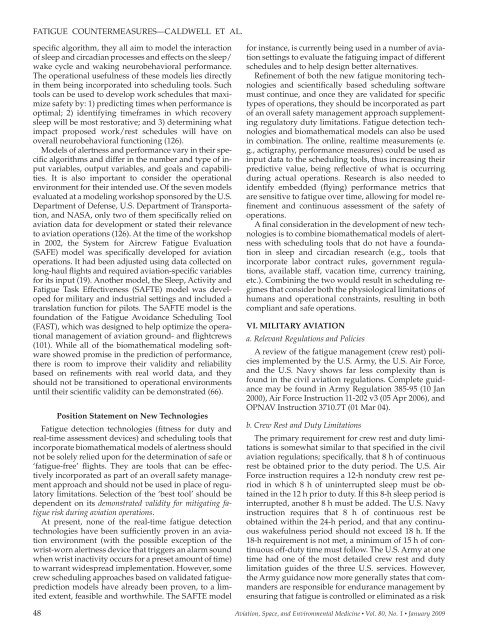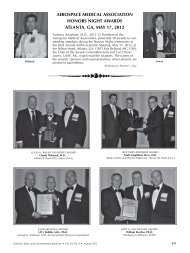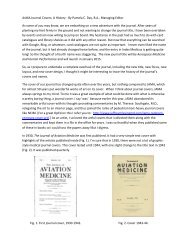Fatigue Countermeasures in Aviation - Aerospace Medical Association
Fatigue Countermeasures in Aviation - Aerospace Medical Association
Fatigue Countermeasures in Aviation - Aerospace Medical Association
Create successful ePaper yourself
Turn your PDF publications into a flip-book with our unique Google optimized e-Paper software.
FATIGUE COUNTERMEASURES — CALDWELL ET AL.<br />
specific algorithm, they all aim to model the <strong>in</strong>teraction<br />
of sleep and circadian processes and effects on the sleep/<br />
wake cycle and wak<strong>in</strong>g neurobehavioral performance.<br />
The operational usefulness of these models lies directly<br />
<strong>in</strong> them be<strong>in</strong>g <strong>in</strong>corporated <strong>in</strong>to schedul<strong>in</strong>g tools. Such<br />
tools can be used to develop work schedules that maximize<br />
safety by: 1) predict<strong>in</strong>g times when performance is<br />
optimal; 2) identify<strong>in</strong>g timeframes <strong>in</strong> which recovery<br />
sleep will be most restorative; and 3) determ<strong>in</strong><strong>in</strong>g what<br />
impact proposed work/rest schedules will have on<br />
overall neurobehavioral function<strong>in</strong>g ( 126 ).<br />
Models of alertness and performance vary <strong>in</strong> their specific<br />
algorithms and differ <strong>in</strong> the number and type of <strong>in</strong>put<br />
variables, output variables, and goals and capabilities.<br />
It is also important to consider the operational<br />
environment for their <strong>in</strong>tended use. Of the seven models<br />
evaluated at a model<strong>in</strong>g workshop sponsored by the U.S.<br />
Department of Defense, U.S. Department of Transportation,<br />
and NASA, only two of them specifically relied on<br />
aviation data for development or stated their relevance<br />
to aviation operations ( 126 ). At the time of the workshop<br />
<strong>in</strong> 2002, the System for Aircrew <strong>Fatigue</strong> Evaluation<br />
(SAFE) model was specifically developed for aviation<br />
operations. It had been adjusted us<strong>in</strong>g data collected on<br />
long-haul flights and required aviation-specific variables<br />
for its <strong>in</strong>put ( 19 ). Another model, the Sleep, Activity and<br />
<strong>Fatigue</strong> Task Effectiveness (SAFTE) model was developed<br />
for military and <strong>in</strong>dustrial sett<strong>in</strong>gs and <strong>in</strong>cluded a<br />
translation function for pilots. The SAFTE model is the<br />
foundation of the <strong>Fatigue</strong> Avoidance Schedul<strong>in</strong>g Tool<br />
(FAST), which was designed to help optimize the operational<br />
management of aviation ground- and flightcrews<br />
( 101 ). While all of the biomathematical model<strong>in</strong>g software<br />
showed promise <strong>in</strong> the prediction of performance,<br />
there is room to improve their validity and reliability<br />
based on ref<strong>in</strong>ements with real world data, and they<br />
should not be transitioned to operational environments<br />
until their scientific validity can be demonstrated ( 66 ).<br />
Position Statement on New Technologies<br />
<strong>Fatigue</strong> detection technologies (fitness for duty and<br />
real-time assessment devices) and schedul<strong>in</strong>g tools that<br />
<strong>in</strong>corporate biomathematical models of alertness should<br />
not be solely relied upon for the determ<strong>in</strong>ation of safe or<br />
‘ fatigue-free ’ flights. They are tools that can be effectively<br />
<strong>in</strong>corporated as part of an overall safety management<br />
approach and should not be used <strong>in</strong> place of regulatory<br />
limitations. Selection of the ‘ best tool ’ should be<br />
dependent on its demonstrated validity for mitigat<strong>in</strong>g fatigue<br />
risk dur<strong>in</strong>g aviation operations .<br />
At present, none of the real-time fatigue detection<br />
technologies have been sufficiently proven <strong>in</strong> an aviation<br />
environment (with the possible exception of the<br />
wrist-worn alertness device that triggers an alarm sound<br />
when wrist <strong>in</strong>activity occurs for a preset amount of time)<br />
to warrant widespread implementation. However, some<br />
crew schedul<strong>in</strong>g approaches based on validated fatigueprediction<br />
models have already been proven, to a limited<br />
extent, feasible and worthwhile. The SAFTE model<br />
for <strong>in</strong>stance, is currently be<strong>in</strong>g used <strong>in</strong> a number of aviation<br />
sett<strong>in</strong>gs to evaluate the fatigu<strong>in</strong>g impact of different<br />
schedules and to help design better alternatives.<br />
Ref<strong>in</strong>ement of both the new fatigue monitor<strong>in</strong>g technologies<br />
and scientifically based schedul<strong>in</strong>g software<br />
must cont<strong>in</strong>ue, and once they are validated for specific<br />
types of operations, they should be <strong>in</strong>corporated as part<br />
of an overall safety management approach supplement<strong>in</strong>g<br />
regulatory duty limitations. <strong>Fatigue</strong> detection technologies<br />
and biomathematical models can also be used<br />
<strong>in</strong> comb<strong>in</strong>ation. The onl<strong>in</strong>e, realtime measurements (e.<br />
g., actigraphy, performance measures) could be used as<br />
<strong>in</strong>put data to the schedul<strong>in</strong>g tools, thus <strong>in</strong>creas<strong>in</strong>g their<br />
predictive value, be<strong>in</strong>g reflective of what is occurr<strong>in</strong>g<br />
dur<strong>in</strong>g actual operations. Research is also needed to<br />
identify embedded (fly<strong>in</strong>g) performance metrics that<br />
are sensitive to fatigue over time, allow<strong>in</strong>g for model ref<strong>in</strong>ement<br />
and cont<strong>in</strong>uous assessment of the safety of<br />
operations.<br />
A f<strong>in</strong>al consideration <strong>in</strong> the development of new technologies<br />
is to comb<strong>in</strong>e biomathematical models of alertness<br />
with schedul<strong>in</strong>g tools that do not have a foundation<br />
<strong>in</strong> sleep and circadian research (e.g., tools that<br />
<strong>in</strong>corporate labor contract rules, government regulations,<br />
available staff, vacation time, currency tra<strong>in</strong><strong>in</strong>g,<br />
etc.). Comb<strong>in</strong><strong>in</strong>g the two would result <strong>in</strong> schedul<strong>in</strong>g regimes<br />
that consider both the physiological limitations of<br />
humans and operational constra<strong>in</strong>ts, result<strong>in</strong>g <strong>in</strong> both<br />
compliant and safe operations.<br />
VI. MILITARY AVIATION<br />
a. Relevant Regulations and Policies<br />
A review of the fatigue management (crew rest) policies<br />
implemented by the U.S. Army, the U.S. Air Force,<br />
and the U.S. Navy shows far less complexity than is<br />
found <strong>in</strong> the civil aviation regulations. Complete guidance<br />
may be found <strong>in</strong> Army Regulation 385-95 (10 Jan<br />
2000), Air Force Instruction 11-202 v3 (05 Apr 2006), and<br />
OPNAV Instruction 3710.7T (01 Mar 04).<br />
b. Crew Rest and Duty Limitations<br />
The primary requirement for crew rest and duty limitations<br />
is somewhat similar to that specified <strong>in</strong> the civil<br />
aviation regulations; specifically, that 8 h of cont<strong>in</strong>uous<br />
rest be obta<strong>in</strong>ed prior to the duty period. The U.S. Air<br />
Force <strong>in</strong>struction requires a 12-h nonduty crew rest period<br />
<strong>in</strong> which 8 h of un<strong>in</strong>terrupted sleep must be obta<strong>in</strong>ed<br />
<strong>in</strong> the 12 h prior to duty. If this 8-h sleep period is<br />
<strong>in</strong>terrupted, another 8 h must be added. The U.S. Navy<br />
<strong>in</strong>struction requires that 8 h of cont<strong>in</strong>uous rest be<br />
obta<strong>in</strong>ed with<strong>in</strong> the 24-h period, and that any cont<strong>in</strong>uous<br />
wakefulness period should not exceed 18 h. If the<br />
18-h requirement is not met, a m<strong>in</strong>imum of 15 h of cont<strong>in</strong>uous<br />
off-duty time must follow. The U.S. Army at one<br />
time had one of the most detailed crew rest and duty<br />
limitation guides of the three U.S. services. However,<br />
the Army guidance now more generally states that commanders<br />
are responsible for endurance management by<br />
ensur<strong>in</strong>g that fatigue is controlled or elim<strong>in</strong>ated as a risk<br />
48 <strong>Aviation</strong>, Space, and Environmental Medic<strong>in</strong>e x Vol. 80, No. 1 x January 2009





